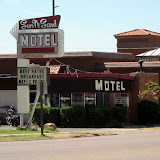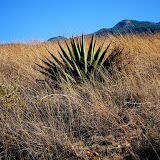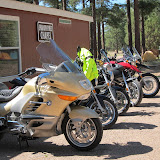PLANNING to Land Cruise
(Texas to Carlsbad Canyons)
FLORIDA
Usually, when a cruiser couple ties up on land, perhaps puts a "For Sale" sign on the boat aand begins to drag their personal effects off by the duffel-bag load it is called "burying the anchor." It usually happens after a great deal of soul searching and agonized decision making as well as a plan for the next steps --on land.
For us, Dan and Kathy, the owners of IPY440 hull 16 named Sea Star we simply took a vacation from sea travel after close to three years. We tied up in Titusville, FL and planned a land trip. Neither of us had seen the United States west of New York except for drive throughs so we decided to visit some of the National Parks in the West and into Canada. Dan's dream also included getting back into motorcycling after quite a number of years without riding a bike. We thought about that for a long while and bought a R1200RT BMW and began to ride again in Florida. To brush up on skills he took a driving class. That worked out well, we were both excited about riding, so we started equiping the bike for the long haul we were planning to take.
We decided that we had been tent campers when younger and anyway only a tent would do for a motorcycle trip so by purchasing the latest and greatest new lightweight equipment, we would be good to go. After all, we both had become addicted to internet motorcycle forums like BMW Owners and Adventure Rider so we were thinking -just bungee on the equipment and ride away.
For us, things didn't pan out like that. The piles on the boat floor were growing as we read about the absolutely needed equipment. I think the final straw was the strong suggestion that to enter the Western parks, a minimum of five gallons of fresh water and ice would be needed. How do you carry a five gallon igloo cooler on a motorcycle? We thought-maybe we need another option.
We had recently bought a Subaru Forester All Wheel Drive vehicle to get around the dock and to the East coast. We had a trailer hitch put on, fit a light-weight Aluma trailer to carry the bike, loaded up the car to the ceiling with all the carefully selected gear, oh so carefully strapped the bike down, and drove off in the car to the Texas Hill Country.
THE INFORMATION ON THIS TRAVEL BLOG IS TO THE BEST OF MY RECOLLECTION AND DEPENDENT ON WHAT RESOURCE MATERIAL I KEPT OVER THE THREE MONTHS. IF THERE ARE GLARING INACCURACIES PLEASE LET ME KNOW. I ESPECIALLY APOLOGISE TO OTHER BIRDERS FOR NOT INCLUDING ALL OUR MAJOR SIGHTINGS WITH SPECIFIC LOCATION.
Also, I've upped the resolution on my photo uploads. They will probably take a few more seconds to load, and for captions to appear. If you can't see the pictures clearly, press pause and allow a bit of time for photos to load.
Sometimes after 50 pictures a new page appears.
TEXAS HILL COUNTRY
Dan felt it was important to beat the heat in the West, and it took us awhile in Florida, longer than we had hoped, to begin the trip. We arrived at Neils Lodges on the Rio Frio in just two days. There Dan removed the bike, started riding in this area known for great motorcycling and never looked back.
Riding and birdwatching were our main pursuits for about a week as we walked on back roads at Las Maples along the Rio Frio and open fields in quest of the Black -capped Vireo, a secretative bird with a distictive call, which we never did see, but heard. I've try to recreate our list here. The blackboads in the pics were posted at Las Maples. We were told stories of where the elusive Colima Warbler was recently located at Big Bend National Park, and watched the nightly show of birds at the drip spout on Neil's property.
One evening after reading a description of the event we joined a small group at the entrance to a private road
for the nightly Frio Bat Cave display, which was amazing! Three million, we were informed, Mexican freetail bats pour from a small opening in a cave to feed, and return by morning. In the bats' emergence from the cave the predators such as Red tailed hawks and Perigrin Falcons have learned to stalk their dinner of juicy bat. Here are some pics (slideshow) around Texas Hill Country and video of the bat extravaganza.
NOW TO TEXAS BIG BEND
Great start we thought, and next we were off to Big Bend National Park by way of Marathon, TX., me in the car with the trailer and Dan on the Beemer. We usually met up a few times during the traveling day at rest stops or for lunch. I got pretty good at catching a glimpse of his neon green jacket and making the stop. I had to learn to find places long enough to park and turn with the trailer but since RV's and much larger trailers abound out west it was doable almost every time.
I had been following a blog of the local Big Bend area birds written by employees at Marathon Trailer Park. We talked to Heidi and Matt, set up our new Nemo 3 person tent for the first time and spent a few days around Marathon, specifically the Post Park,at Matt's suggestion, before heading on to Big Bend. We entered at Panther Junction, Dan on bike and me with car, trailer and the five gallon container filled with ice. We carried lots of water, and some food.
Our eyes simply popped out of our heads at the canyon scenery along the way and, sooo different from New England. Soon we arrived at Rio Grande Village, selected our campsite from many, ours had a concrete pad with roof over a solid picnic table, and a soft spot under Cottonwood trees for a tent. We were home for the next few days.
Near the campsite was a five foot by three foot deep metal box with front opening doors, our first introduction to "the bear box", designed to keep food and gear from attracting unwanted visits from hungry bears, and another animal new to us, the Javelina. The Javelina, or peccary, looks like a wild pig, has tusks and dainty, little feet but can be a worse nuisance than a bear. Lots more birds and animals came onto the list, like the Golden-fronted Woodpecker that landed in my still warm from eggs frying pan, Roadrunners, huge Jack rabbits, cottontails, deer and coyote.
Daily we rode the paved roads exploring on the bike but we used the car a bit, too. Big Bend has many marked and maintained 4X4 roads that we could explore. We bumped a loong 4 wheel drive to Pipe Springs, learning what our car could do,(or not do with its ground clearance) and had a few special days of zooming around on the BMW staying on the pavement as it was pretty dusty, not to mention windy. We never did track down the Colima Warbler there in the park.
One evening and night at the campsite the wind came up suddenly and became very frightening to us as it swirled every which way, kicking up dirt and throwing branches at our little tent home. We couldn't cook and that night we stayed in the car trying to sleep as the noise of the wind rose and fell, thinking about the large branches of the Cottonwood OVER our tent. In the morning the park service had small bulldozers removing debris from the camp!
In a few days and after a wonderful, twisty ride to Santa Elena Canyon on the bike, we picked up the tent and gear and headed toward another part of Big Bend, the Chisos Basin Campground. We we fortunate to meet two other couples riding BMW's and had a few fun evenings sharing stories and places to "not miss." Dan and I admired the other folks ability to have all their needs on their bikes. (By that time we had learned that ALL the parks have running water available at what they designate as 'developed' campsites (like where we camped.) Developed sites also usually have flush or pit toilets-no showers but in Big Bend showers were available at the General Store for a small fee. The General Stores in Big Bend are concessions and sell many camping necessities, blankets, tents, pegs. They also stock water, ice, beer, wine and limited food supplies.)
Here are pics from Big Bend. Enjoy the slide show. It might take a bit to load the 80 pictures.
After Big Bend we planned a route towards Arizona by way of Davis Mts, where we actually saw the destruction and blackening caused by the recent fire there. The wildfire had burned more than 300,000 acres and threatened the McDonald Observatory which reopened by the time we arrived, so we were treated to a night of exploring the Texas skys on their smaller telescopes. The larger telescopes had been removed for their safety and were not available to the public yet.
To our surprise we met the same couple riding a Beemer whom we had seen at Big Bend at a campsite in the Guadalupe Mountains. The next day we decided to take a day motorcycle trip with them to NEW MEXICO and the Carlsbad Canyons, only about 40 miles. The day was great, a litttle windy, but the Caverns were magical. We walked over a mile and a half into the mountain on concrete walkways. Then, we were expected to take the elevator out because of the time we entered. Well, OK!
ARIZONA Mid May 2011- next log section.
There are dots on the map in the Western states to illustrate the route of our trip. To access the correct spot on the map, use the left and arrow up or down buttons to find the orange dots.







